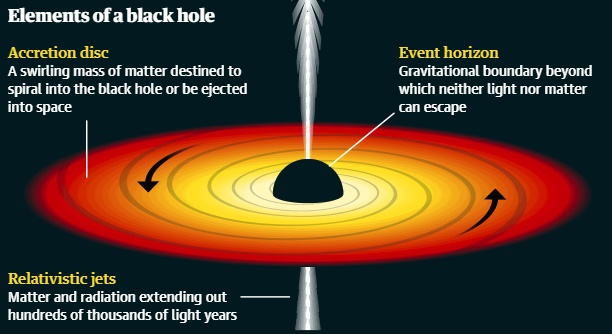Intermediate-Mass Black Hole | 04 Sep 2020
Why in News
Analysis of signals from gravitational waves detected in 2019 at the Laser Interferometer Gravitational-Wave Observatory (LIGO), the USA and the detector Virgo, Italy have indicated a black hole with unusual mass
- These waves were a result of a collision between two black holes billions of years ago.
Key Points
- The signal has been named GW190521 and likely represented the instant that the two black holes merged.
- It lasted less than one-tenth of a second.
- It was calculated to have come from roughly 17 billion light-years away, a time when the universe was about half its age.
- Out of the two, the larger black hole was of 85 solar masses and the smaller black hole was of 66 solar masses. Post-merger they created a new black hole of about 142 solar masses and energy equivalent to 8 solar masses was released in the form of gravitational waves, leading to the strongest ever wave detected by scientists so far.
- A solar mass is the mass of the sun or more precisely, it is 1.989 x 1030 kilograms, which is equivalent to about 333,000 Earths.
- Astronomers use a solar mass as a basic unit of mass.
- Unusual Mass Category:
- The black hole with 85 solar masses falls in an “intermediate-mass” range (first-ever to be observed) and it defies the traditional knowledge of how black holes are formed.
- According to traditional knowledge, stars that could give birth to black holes between 65 and 120 solar masses do not do so because they blow themselves apart when they die, without collapsing into a black hole.
- In the merger leading to the GW190521 signal, the larger black hole was well within the unexpected range, known as the pair-instability mass gap.
- Suggested Reasons for Unusual Mass:
- The researchers suggest that the larger 85-solar-mass black hole was not the product of a collapsing star but was itself the result of a previous merger.
Black Hole
- It refers to a point in space where the matter is so compressed as to create a gravity field from which even light cannot escape.
- The concept was theorized by Albert Einstein in 1915 and the term ‘black hole’ was coined in the mid-1960s by American physicist John Archibald Wheeler.
- All the black holes observed so far belong to two categories:
- One category ranges between a few solar masses and tens of solar masses. These are thought to form when massive stars die.
- The other category is of supermassive black holes. These range from hundreds of thousands to billions of times that of the sun from the Solar system to which Earth belongs.
- In April 2019, the scientists at the Event Horizon Telescope Project released the first-ever image of a Black Hole (more precisely, of its shadow).
- The image was made possible by the Event Horizon Telescope which is a group of 8 radio telescopes (used to detect radio waves from space) located in different parts of the world.
- Gravitational waves are created when two black holes orbit each other and merge.
Gravitational Waves
- These are invisible ripples that form when:
- A star explodes in a supernova.
- Two big stars orbit each other.
- Two black holes merge.
- They travel at the speed of light and squeeze and stretch anything in their path.
- As a gravitational wave travels through space-time, it causes it to stretch in one direction and compress in the other, Any object that occupies that region of space-time also stretches and compresses as the wave passes over them, though very slightly, which can only be detected by specialized devices like LIGO.
- Gravitational Waves are a relatively new field of discovery.
- These were proposed by Albert Einstein in his General Theory of Relativity, over a century ago.
- However, the first gravitational wave was actually detected by LIGO only in 2015.

